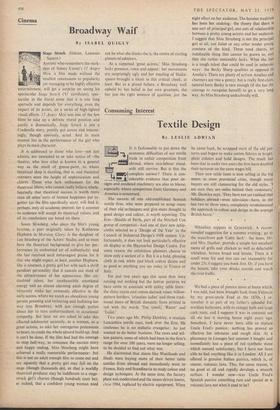Consuming Interest
Textile Design
By LESLIE ADRIAN The success of one old-established Scottish textile firm, who were prepared to scrap many of their old techniques and give more thought to good design and colour, is worth reporting. The firm—Shields of Perth, part of the Mitchell Cox group of companies—had one of their 'new table- cloths selected as a 'Design of the Year' in the Council of Industrial Design's 1958 contest. Un- fortunately, it does not look particularly effective on display at the Haymarket Design Centre. For some reason the exhibition planners choose to show only a section of it. But it is a bold, pleasing cloth in red, white and black, cotton denim and as good as anything you see today in France or Italy.
Yet just two years ago this same firm were turning out nothing but the horror patterns we have come to associate with utility table linen: the shiny rayon and cotton damask roses, willow- pattern borders, 'crinoline ladies' and those tradi- tional items of British domestic linen printed in red with the words 'Tea towel,' Razor' and 'Toilet.'
Two years ago Mr. Philip Dunkley, a resolute Lancashire textile man, took over the firm. He confesses he is no aesthetic evangelist : he just wanted to do better business. The roses and wil- low pattern, some of which had been in the firm's range for over 100 years, were no longer selling, So he decided to find out what was.
He discovered that stores like Woollands and Heals were buying more of their better table textiles from abroad and immediately went to France, Italy and Scandinavia to study colour and design techniques. At the same time, the factory plant wa's modernised and the steam-driven looms, circa 1904, replaced by electric equipment. When he came back, he scrapped most of the old pat- tern& and began to make cotton fabrics in bright. plain colours and bold designs. The result has been that in under two years the firm have doubled their turnover on the same wages bill.
Their new table linen is now selling in the big stores in most provincial cities, though many buyers are still clamouring for the old styles. am sure they are miles behind their customers,' Mr. Dunkley says. 'They have not yet realised that holidays abroad—even television—have, in the last two or three years, completely revolutionised the approach to colour and design in the average British home.'
Whitebait suppers in Greenwich. A recom- mended suggestion for a summer evening: go to the waterfront pub 'Cutty Sark' : the hosts, Mr. and Mrs. Dunbar, provide a simple but excellent menu of grills and chicken as well as delectable whitebait, brown bread and lemon. There is a small wine list and two can eat reasonably for under 25s. 1 suggest you book first. Or, if you have the leisure, take your drinks outside and watch the river traffic.
* * *
We.had a piece of pUrnice stone at home which, I was told, had been brought back from Valencia by my great-uncle Fred in the 1870s. I re- member it as part of my father's splendid Ed- wardian bathroom, with its canopy bath and large cork mats, and I suppose it was in constant use till we lost it moving house eight years ago. Somehow, I have never been able to replace Uncle Fred's pumice : nothing has proved so effective for inkstains and rough skin. At a pharmacy in Limoges last summer I bought and immediately lost a piece of red synthetic stone which seemed satisfactory, but I have not been able to' find anything like it in London. All I am offered is genuine Italian pumice, which is, of course, volcanic lava. This, for some reason, is no good at all and rapidly develops a smooth surface. I wonder now—was Uncle Fred's Spanish pumice something rare and special or is volcanic lava not what it used to be?


































 Previous page
Previous page